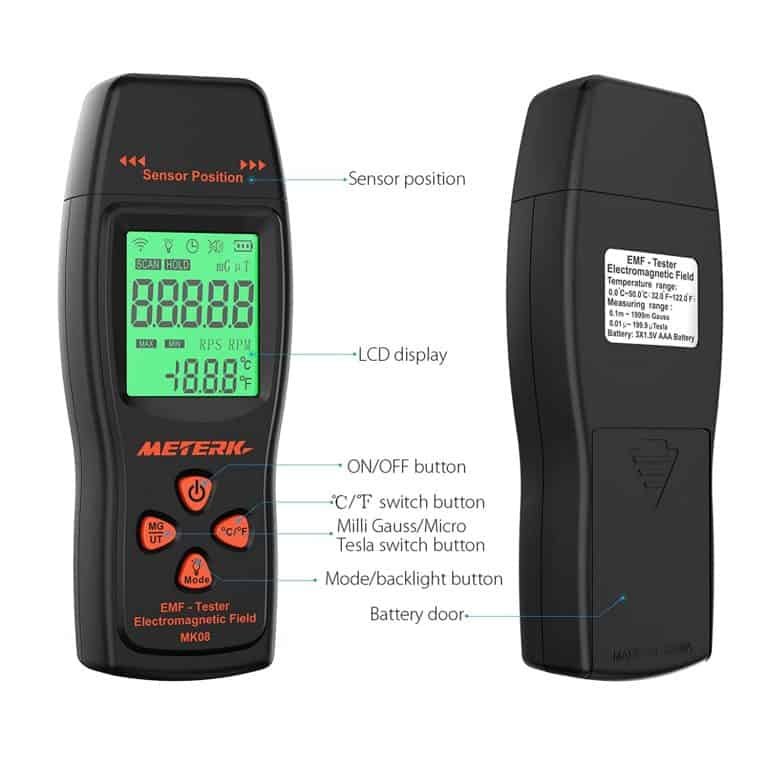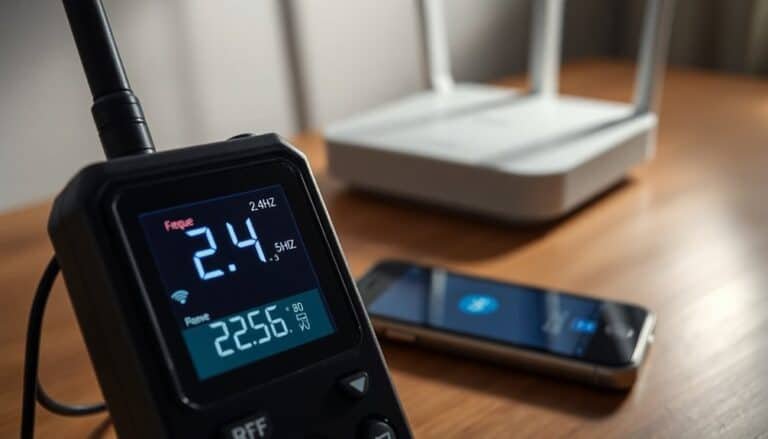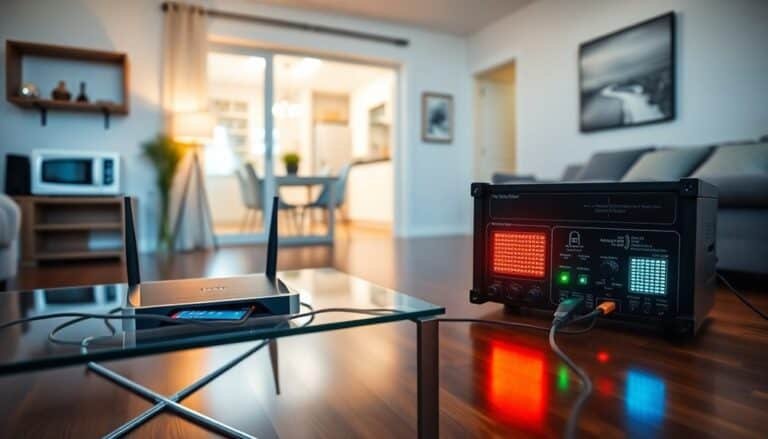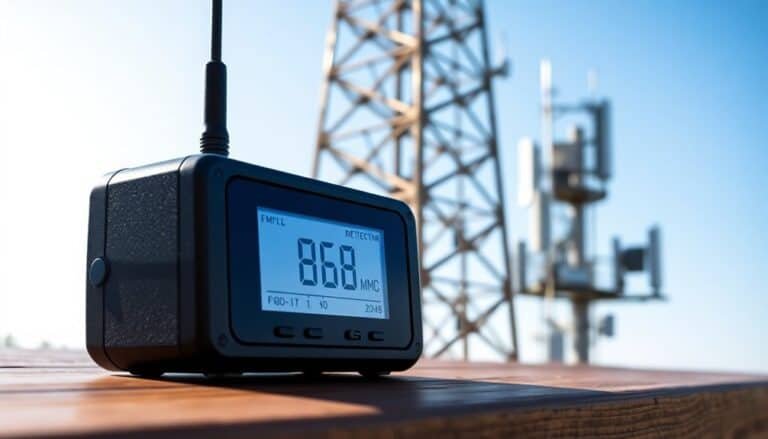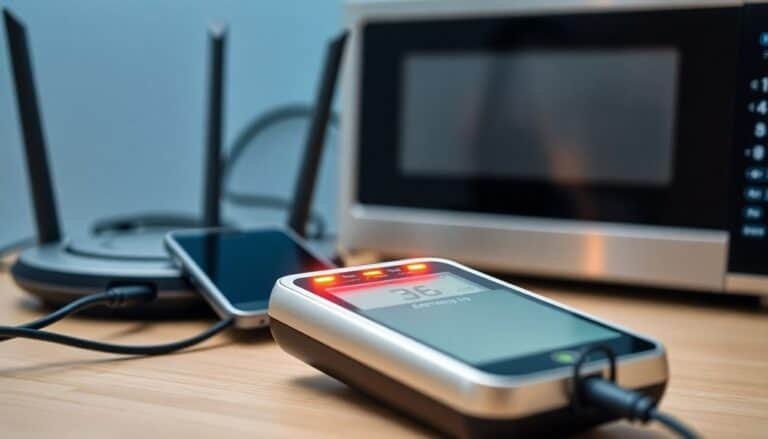How to Measure EMFs in Your Home
For measuring EMFs at home, use a reliable EMF meter like the Cornet ED88T or Trifield TF2 to assess magnetic, electric, and RF fields. Focus on key areas such as bedrooms and workspaces, and ensure the meter is calibrated for accuracy.
To reduce exposure, increase distance from electronic devices and remove unnecessary appliances. For further strategies and safety tips, additional resources are available.
Disclaimer: As an affiliate, I may collect a share of sales from the links on this page.
Understanding EMFs and Their Frequency
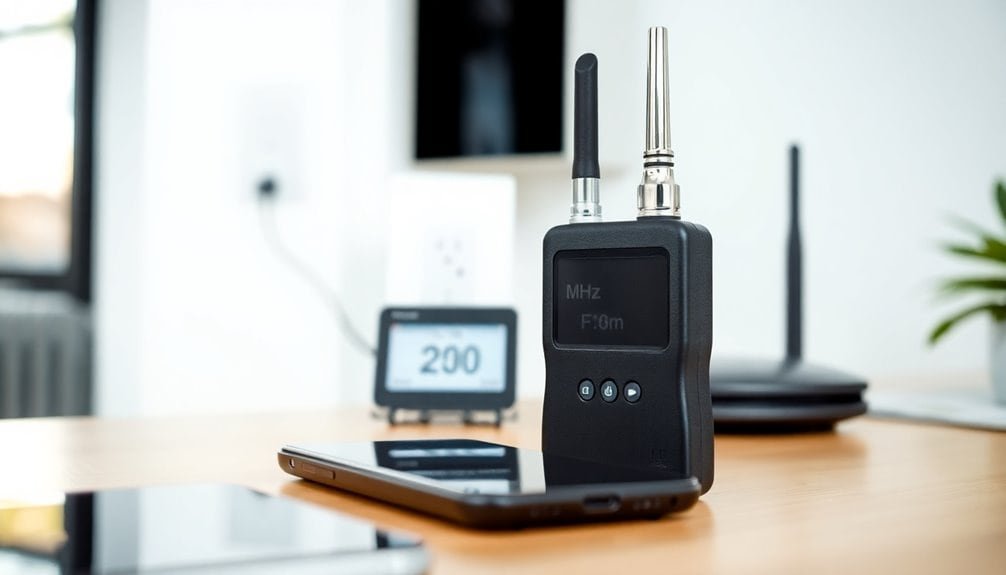
While electromagnetic fields (EMFs) are often invisible to the naked eye, they play a significant role in our daily lives. EMFs result from electric charges and changing electric currents, combining electric and magnetic fields. Electromagnetic fields are classified as non-ionising radiation, which means they do not directly ionize atoms or molecules and prevent genetic damage. However, long-term health risks associated with non-ionizing radiation have raised concerns among researchers and the public alike.
You’ll encounter different types: static, low-frequency, and high-frequency, categorized by their frequency range. Low-frequency EMFs, measured in Hertz (Hz), include power lines, while high-frequency EMFs, from 100 kHz to 300 GHz, encompass Wi-Fi and microwaves.
Essential Tools for EMF Measurement
EMF meters are essential for accurately evaluating electromagnetic fields in various environments. Handheld models give quick detection, measuring RF, LF, and EF types, like the Cornet ED88T, Trifield TF2, and Acoustimeter. Different types of meters provide varied insights into EMF exposure, making it vital to choose the right one for your specific needs. Multi-function meters include electric field probes and magnetic field sensors, while audio outputs and visual indicators help locate sources. Real-time LCD displays enhance convenience, allowing immediate results. Three-axis magnetic sensors guarantee precise readings, regardless of orientation. Some devices feature weighted modes for relevant body effects, ensuring they account for advanced measurement methods in their assessments. Compact designs simplify portability, making them perfect for home assessments. Regular calibration maintains accuracy, guaranteeing consistent readings over time.
Selecting the Right EMF Meter
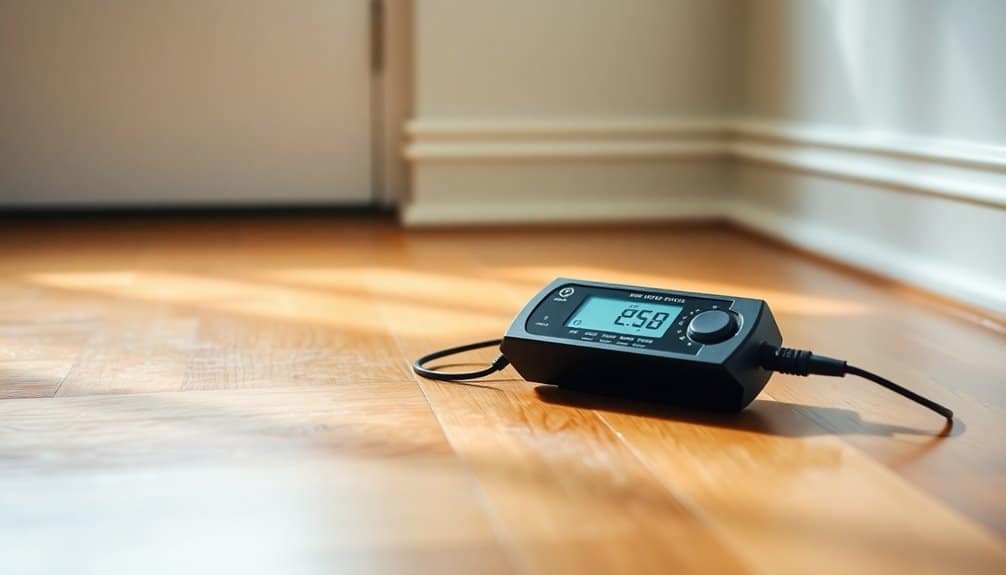
Selecting the right EMF meter is essential for effectively measuring electromagnetic fields in your environment.
Consider the following factors when choosing your meter:
- Types of EMF Detected: Confirm it measures magnetic, electric, and RF fields. Meters specific to ELF waves cannot measure RF and microwave outputs.
- User-Friendly Design: Look for intuitive interfaces and digital displays for easy data analysis.
- Advanced Features: Decide if you need capabilities like peak hold and weighted modes for specific assessments, as these features can improve accuracy in readings.
- Price Range and Reviews: Select a reputable brand within your budget based on user feedback.
Using these criteria will help guarantee you invest in an EMF meter that meets your specific measurement needs.
Key Locations for EMF Measurement
When measuring electromagnetic fields (EMFs), identifying key locations in your environment is essential.
Focus on bedrooms, as measuring over beds reveals exposure during sleep.
Examine sitting areas, where you spend considerable time, and workspaces near desks and computers.
Don’t forget hallways, checking for EMF sources like wiring and routers.
Pay special attention to areas near electrical panels, where high EMF levels can occur.
Outdoor measurements are also critical, especially near power lines and cell towers.
Finally, include areas around Wi-Fi routers, televisions, and microwaves, as they often yield the highest EMF readings in homes.
Effective Methods for Measuring EMFs
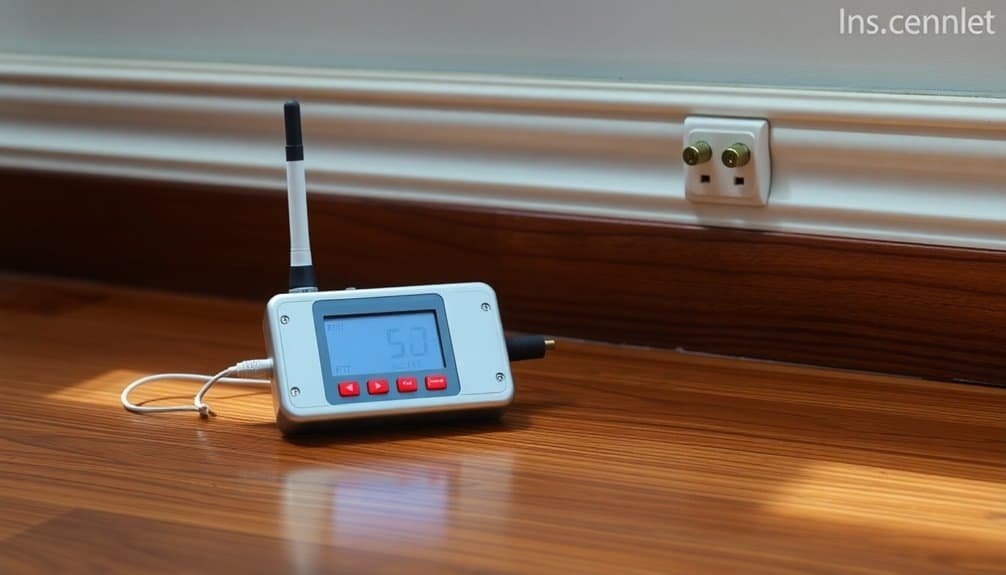
A precise measurement of electromagnetic fields (EMFs) requires appropriate tools and carefully planned steps.
To effectively measure EMFs in your home, consider using these tools:
- Gaussmeter: Measures low-frequency magnetic fields from appliances.
- RF Meter: Detects radiofrequency fields from Wi-Fi and phones.
- Trifield EMF Meter: Assesses magnetic, electric, and RF fields together.
- Dirty Electricity Meter: Identifies dirty electricity as a pollution source.
Start by turning off electricity. Set your meter to sensitive ranges, perform a walk-through survey, and check near appliances.
Compare results to safety guidelines for thorough analysis.
Safety and Health Considerations
Understanding the safety and health implications of electromagnetic fields (EMFs) is essential for informed decision-making. Current guidelines suggest keeping home exposure below 2.5 mG to minimize potential risks.
Research hasn’t confirmed a clear link between low-level EMF exposure and health issues, like headaches or anxiety, although some individuals report symptoms. These symptoms may stem from other environmental factors, rather than EMFs.
The WHO states that low-level EMF exposure poses minimal danger. Generally, typical indoor levels are low, often below 3 mG.
Awareness of EMF exposure can help you make educated decisions regarding your home environment and overall health.
Practical Tips for Reducing EMF Exposure
Reducing your exposure to electromagnetic fields (EMFs) can be straightforward if you implement practical measures in your daily life.
Here are some effective strategies:
- Increase distance from electrical appliances when not in use.
- Turn off devices to minimize power use and exposure.
- Opt for toaster ovens instead of microwaves for cooking.
- Keep all electronic devices at least one meter away from your bed.
These changes can considerably lower your EMF exposure, creating a healthier living environment.
The Importance of Regular Monitoring
Regular monitoring of electromagnetic fields (EMFs) plays a significant role in managing exposure and safeguarding health. It helps you identify fluctuations in EMF levels over time, allowing for timely adjustments.
You can pinpoint hotspots using EMF meters, enabling targeted reduction strategies. By monitoring regularly, you can adapt to new sources, like recent appliances. This proactive approach not only guarantees peace of mind but supports preventive measures against potential health concerns.
Additionally, consistent monitoring aids in energy efficiency and enhances home safety by informing decisions about placement and use of devices, ultimately contributing to a healthier living environment.
When to Seek Professional Advice
When electromagnetic field (EMF) levels raise concerns, knowing when to seek professional advice can greatly enhance safety and health.
Consider hiring an expert under these conditions:
- High Exposure Levels: You live near transmission lines or cell towers.
- DIY Limitations: Your measurements seem inconsistent or unreliable.
- Complex Electrical Systems: Your home has intricate wiring requiring assessment.
- Specialized Equipment Needs: Advanced tools, like oscilloscopes, are necessary for accurate readings.
Professionals guarantee compliance with standards, provide thorough reports, and offer targeted remediation strategies to effectively reduce EMF exposure in your environment.
Frequently Asked Questions
Can EMF Exposure Affect Pets Differently Than Humans?
Yes, EMF exposure can affect pets differently than humans. Due to their smaller size and unique biological sensitivities, pets may experience behavioral changes or health impacts that humans might not notice. Keep an eye on them!
How Can I Tell if My EMF Meter Is Accurate?
To guarantee your EMF meter’s accurate, check its calibration regularly, confirm it’s from a reputable manufacturer, and verify compliance with relevant standards. Doing this helps maintain trust in your measurements and protects your health.
What Are Common Sources of EMFS in Modern Homes?
In modern homes, common sources of EMFs include appliances like microwaves and washing machines, electronic devices such as cell phones and computers, and smart home gadgets like Wi-Fi routers. Being aware helps you manage exposure effectively.
Is There a Safe Level of EMF Exposure?
Think of EMFs like a barbecue: too much smoke is harmful, but a little adds flavor. Safe exposure levels exist—up to 70 mV/m for high-frequency EMFs, but staying cautious keeps your environment healthier and happier.
Can Household Plants Help Reduce EMF Levels?
You might hope household plants can reduce EMF levels, but scientific evidence supporting this claim is limited. While they improve air quality and aesthetics, relying on them for EMF reduction isn’t strongly justified.
Conclusion
To ensure a safe home, it’s important to understand and measure EMFs. Using accurate EMF meters helps identify exposure levels. Focus on key areas for measurement and apply strategies to reduce exposure. Regular monitoring keeps your environment healthy. If unsure, seek professional advice for guidance in EMF management.

